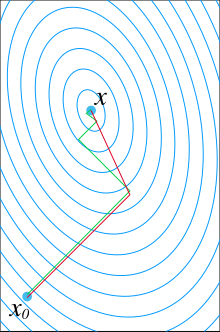
In mathematics, the conjugate gradient method is an algorithm for the numerical solution of particular systems of linear equations, namely those whose matrix is positive-semidefinite. The conjugate gradient method is often implemented as an iterative algorithm, applicable to sparse systems that are too large to be handled by a direct implementation or other direct methods such as the Cholesky decomposition. Large sparse systems often arise when numerically solving partial differential equations or optimization problems.
The conjugate gradient method can also be used to solve unconstrained optimization problems such as energy minimization. It is commonly attributed to Magnus Hestenes and Eduard Stiefel,[1][2] who programmed it on the Z4,[3] and extensively researched it.[4][5]
The biconjugate gradient method provides a generalization to non-symmetric matrices. Various nonlinear conjugate gradient methods seek minima of nonlinear optimization problems.
- ^ Hestenes, Magnus R.; Stiefel, Eduard (December 1952). "Methods of Conjugate Gradients for Solving Linear Systems" (PDF). Journal of Research of the National Bureau of Standards. 49 (6): 409. doi:10.6028/jres.049.044.
- ^ Straeter, T. A. (1971). On the Extension of the Davidon–Broyden Class of Rank One, Quasi-Newton Minimization Methods to an Infinite Dimensional Hilbert Space with Applications to Optimal Control Problems (PhD thesis). North Carolina State University. hdl:2060/19710026200 – via NASA Technical Reports Server.
- ^ Speiser, Ambros (2004). "Konrad Zuse und die ERMETH: Ein weltweiter Architektur-Vergleich" [Konrad Zuse and the ERMETH: A worldwide comparison of architectures]. In Hellige, Hans Dieter (ed.). Geschichten der Informatik. Visionen, Paradigmen, Leitmotive (in German). Berlin: Springer. p. 185. ISBN 3-540-00217-0.
- ^ Polyak, Boris (1987). Introduction to Optimization.
- ^ Greenbaum, Anne (1997). Iterative Methods for Solving Linear Systems. doi:10.1137/1.9781611970937. ISBN 978-0-89871-396-1.